The merger or de-merger of ministries is back in the national spotlight.
On Saturday, the heads of the government and parliament agreed upon some fundamental changes in the structure of the government, chairman of Majlis Social Commission, Abdolreza Azizi, said.
These agreed upon changes include bisecting the Ministry of Roads and Urban Development into the ministries of “Housing and Urban Development” and “Roads”, transferring the “Municipalities Organization” from the Interior Ministry to the Ministry of Housing and Urban Development, and bringing electricity under the realm of Oil Ministry that would be given a new name.
“The youth department of the Ministry of Sports and Youth will continue as an autonomous organization as per the structural shakeup of the government. The proposed changes will be discussed in Majlis Economic Commission before discussions start on the budget bill for the next fiscal 2018-19,” Azizi was quoted as saying by the Persian daily Shargh.
A new ministry will be formed to focus on rural affairs. The Department of Environment will be upgraded to a ministry to deal with issues associated with natural resources, urban and rural water and wastewater. The Ministry of Industries, Mining and Trade will be separated into two ministries, the commercial division of which will focus on export promotion.
Surprisingly, however, Azizi’s claims of any such agreements about structural changes in the government having been discussed in the Saturday meeting of the head of three branches of power were dismissed by Parviz Esmaeeli of the Presidential Office.
“No discussion was made during the recent meeting about any changes in the structure of the government,” he said.
Strange Decision
Referring to the same report, development economist, Kamal At’hari, said one of the strangest decisions made during the previous administration was the merger of the ministries of “Roads and Transportation” and “Housing and Urban Development”, because these fields need two different management approaches.
Housing and urban planning are integral components of development whereas roads and transportation are engineering disciplines. The fact of the matter is that one of the main reasons the concept of “Right to The City” was first proposed [by Henri Lefebvre in 1968] was to avoid the integration of these two areas, he explained.
At’hari noted that the transition of Municipalities Organization from the Interior Ministry to the Ministry of Housing does not seem logical, as it won’t solve any problem.
“The organization should have been a part of the High Council of Counties and Provinces as per articles 100 to 103 of the Iranian Constitution. Currently, the Interior Ministry’s Municipalities Organization is the link between the government and the municipality, while the Housing Ministry does not have the ability to create coordination between these two institutions,” he said.
“Municipalities belong to the public sector and are not related to Housing and Urban Development Ministry; such a transition is like changing the guardian, although the new guardian is less capable than the former. The better choice would have been to refer to the law of the land i.e. establishment of High Council of Counties and Provinces.”
Increased Exports to Remedy Overcapacity
Overcapacity is the main challenge facing Iran’s industries and the best way to solve this and other economic problems such as unemployment is by prioritizing non-oil exports, a former deputy commerce minister said.
As a proponent of separation of the Ministry of Industries, Mining and Trade, Mahmoud Dodangeh added that the government needs to form a single ministry that would consist of all organizations involved with non-oil exports such as the Organization for Investment Economic and Technical Assistance or Free Zones High Council to promote non-oil exports.
Reza Hajkarim, a board member of the Federation of Water Industry, believes there is no shortage of structure in Iran.
“In fact, one of the main features of the government mindset is to create a new structure for every subject. Due to the current water condition in the Middle East and the fact that by 2050, the region should need 60% more water than now, what is important is to have a national discussion about water rather than a new structure,” he said.
Over the past 50 years, decisions were made about water without the participation of all beneficiaries, namely farmers, environmental watchdogs and chains of water industry. Consequently, these groups are now engaging in the blame game over dam construction and other issues. The establishment of a ministry would prove fruitful if it directs this national discussion.
“In view of the current state of the country’s strategic water reserves, we cannot afford to make another mistake,” Hajkarim said.
Narsi Ghorban, an energy economist, said decision-makers in different sectors of energy all work under a single management worldwide, as these sectors (oil, natural gas and electricity) are interrelated. “Historically, Iran has had the Ministry of Petroleum while natural gas constitutes more than 70% of the energy basket in the country. The best scenario for the future would be to have a ministry under the name of energy along with affiliated departments, including oil, natural gas, electricity and renewable energies,” he said.


